Drivers towards Adopting Modular Integrated Construction for Affordable Sustainable Housing: A Total Interpretive Structural Modelling (TISM) Method
Abstract
1. Introduction
2. Background
2.1. Modular Integrated Construction
2.2. Affordable Sustainable Housing
2.3. Application of MiC in Affordable Sustainable Housing
3. Research Method
3.1. Systematic Literature Review Procedure
3.1.1. Identification
3.1.2. Screening
3.1.3. Eligibility
3.1.4. Inclusion
3.2. Domain Experts Semi-Structured Interview
3.3. Total Interpretive Structural Modelling (TISM) Method
4. Result Findings and Discussions
4.1. Analysis of Drivers towards the Adoption of MiC for ASH
4.1.1. Cost Drivers
4.1.2. Time Drivers
4.1.3. Productivity Drivers
4.1.4. Quality Drivers
4.1.5. Environmental Drivers
4.1.6. Social Drivers
4.1.7. Policy Drivers
4.1.8. Demand Drivers
4.2. TISM Model and MICMAC Analysis for Drivers of MiC Adoption in ASH
- -
- For every V in the cell, the entry (i,j) becomes 1, and entry (j,i) becomes 0.
- -
- For every A in the cell, the entry (i,j) becomes 0, and entry (j,i) becomes 1.
- -
- For every X in the cell, the entry (i,j) becomes 1, and entry (j,i) also becomes 1.
- -
- For every O in the cell, both the entries (i,j) and (j,i) become 0.
4.3. The Strategic Framework of Boosting MiC Adoption in ASH
5. Conclusions
Author Contributions
Funding
Institutional Review Board Statement
Informed Consent Statement
Conflicts of Interest
References
- Mckinsey Co. The Next Normal in Construction. 2020. Available online: https://www.mckinsey.com/business-functions/operations/our-insights/the-next-normal-in-construction-how-disruption-is-reshaping-the-worlds-largest-ecosystem (accessed on 8 March 2022).
- United Nations. Human Rights We Are All in This Together Human Rights Are Critical—For the Response and the Recovery. United Nations. 2020. Available online: https://www.un.org/sites/un2.un.org/files/un_policy_brief_on_human_rights_and_covid_23_april_2020.pdf (accessed on 10 March 2022).
- Forbes. The COVID-19 Pandemic Has Fueled a Crisis in The Housing Market. 2021. Available online: https://www.forbes.com/sites/saibala/2021/04/27/the-covid-19-pandemic-has-fueled-a-crisis-in-the-housing-market/?sh=926e52a59287 (accessed on 10 March 2022).
- Ayat, M.; Kang, C.W. Effects of the COVID-19 pandemic on the construction sector: A systemized review. Eng. Constr. Archit. Manag. 2021. [Google Scholar] [CrossRef]
- Ezennia, I.S.; Hoskara, S.O. Exploring the Severity of Factors Influencing Sustainable Affordable Housing Choice: Evidence from Abuja, Nigeria. Sustainability 2019, 11, 5792. [Google Scholar] [CrossRef]
- Marissa, P. Affordable Housing and Homelessness Challenges across the OECD. OECD Dir. Employ. Labour Soc. Aff. Backgr. 2019, 1, 1–18. Available online: https://www.un.org/development/desa/dspd/wp-content/uploads/sites/22/2019/06/OECD_Affordable-housing-and-homelessness_FINAL.pdf (accessed on 10 March 2022).
- Leishman, C.; Rowley, S. Affordable housing. In The Sage Handbook of Housing Studies; Clapham, D., Clark, W., Gibb, L., Eds.; Sage Publications: London, UK, 2012; pp. 379–396. [Google Scholar]
- Rogers, D.; Power, E.R. The global pandemic is accelerating housing crises. Int. J. Hous. Policy 2021, 21, 315–320. [Google Scholar] [CrossRef]
- De Schutter, O. The Right to Adequate Nutrition. Development 2014, 57, 147–154. [Google Scholar] [CrossRef]
- Powell, A.; Meltzer, A.; Martin, C.; Stone, W.; Liu, E.; Flanagan, K.; Muir, K.; Tually, S. The Construction of Social Housing Pathways Across Australia; Australian Housing and Urban Research Institute: Melbourne, Australia, 2019. [Google Scholar]
- World Economic Forum. Making Affordable Housing a Reality in Cities. World Economic Forum. 2019, pp. 1–60. Available online: http://homeguides.sfgate.com/student-hous (accessed on 8 March 2022).
- U. N. UNFPA. World Population Dashboard|United Nations Population Fund. Available online: https://www.unfpa.org/data/world-population-dashboard (accessed on 5 March 2022).
- Moghayedi, A.; Awuzie, B.; Omotayo, T.; Le Jeune, K.; Massyn, M.; Ekpo, C.; Braune, M.; Byron, P. A Critical Success Factor Framework for Implementing Sustainable Innovative and Affordable Housing: A Systematic Review and Bibliometric Analysis. Buildings 2021, 11, 317. [Google Scholar] [CrossRef]
- Chava, J.; Newman, P. Stakeholder Deliberation on Developing Affordable Housing Strategies: Towards Inclusive and Sustainable Transit-Oriented Developments. Sustainability 2016, 8, 1024. [Google Scholar] [CrossRef]
- Yust, B.L.; Urness, M.; Mitchell, D.; Weber, W.G.; Loosen, A. A qualitative assessment of experiences with selected green technologies in affordable multifamily housing. Hous. Soc. 2015, 42, 239–249. [Google Scholar] [CrossRef]
- Atta, N.; Valle, A.D.; Campioli, A.; Chiaroni, D.; Talamo, C. Construction Technologies for Sustainable Affordable Housing within Fragile Contexts: Proposal of a Decision Support Tool. Sustainability 2021, 13, 5928. [Google Scholar] [CrossRef]
- Brissi, S.G.; Debs, L.; Elwakil, E. A Review on the Factors Affecting the Use of Offsite Construction in Multifamily Housing in the United States. Buildings 2020, 11, 5. [Google Scholar] [CrossRef]
- Souza, E. Prefabrication Could Make Housing Construction More Affordable. ArchDaily. 2021. Available online: https://www.archdaily.com/968367/prefabrication-could-make-housing-construction-more-affordable?utmmedium=email&utmsource=ArchDaily%20List&kth=2,692,318#or (accessed on 8 March 2022).
- Riggs, W.; Sethi, M.; Meares, W.L.; Batstone, D. Prefab micro-units as a strategy for affordable housing. Hous. Stud. 2020, 9, 1–27. [Google Scholar] [CrossRef]
- Zhang, S.; Rong, X.; Bakhtawar, B.; Tariq, S.; Zayed, T. Assessment of Feasibility, Challenges, and Critical Success Factors of MiC Projects in Hong Kong. J. Arch. Eng. 2021, 27, 4020047. [Google Scholar] [CrossRef]
- Abdelmageed, S.; Zayed, T. A study of literature in modular integrated construction—Critical review and future directions. J. Clean. Prod. 2020, 277, 124044. [Google Scholar] [CrossRef]
- Wu, W.-S.; Yang, C.-F.; Chang, J.-C.; Château, P.-A.; Chang, Y.-C. Risk assessment by integrating interpretive structural modeling and Bayesian network, case of offshore pipeline project. Reliab. Eng. Syst. Saf. 2015, 142, 515–524. [Google Scholar] [CrossRef]
- Suprun, E.; Sahin, O.; Stewart, R.A.; Panuwatwanich, K.; Shcherbachenko, Y. An Integrated Participatory Systems Modelling Approach: Application to Construction Innovation. Systems 2018, 6, 33. [Google Scholar] [CrossRef]
- Adabre, M.A.; Chan, A.P. Critical success factors (CSFs) for sustainable affordable housing. Build. Environ. 2019, 156, 203–214. [Google Scholar] [CrossRef]
- Goodier, C.I.; Gibb, A.G. Future opportunities for offsite in the UK. Constr. Manag. Econ. 2007, 25, 585–595. [Google Scholar] [CrossRef]
- Goodier, C.; Gibb, A.; Ashley, D.; Taylor, M. Buildoffsite Glossary of Terms; DTI Buildoffsite: London, UK, 2006. [Google Scholar]
- Khan, A.; Yu, R.; Liu, T. A Systematic Review of Risks in Modular Integrated Construction Practice. In Proceedings of the 44th AUBEA Conference, Geelong, Australia, 27–29 October 2021; pp. 344–354. [Google Scholar]
- Pan, W.; Hon, C.K. Briefing: Modular integrated construction for high-rise buildings. Proc. Inst. Civ. Eng. Munic. Eng. 2020, 173, 64–68. [Google Scholar] [CrossRef]
- Winch, G. Zephyrs of creative destruction: Understanding the management of innovation in construction. Build. Res. Inf. 1998, 26, 268–279. [Google Scholar] [CrossRef]
- Baldwin, C.Y.; Clark, K.B. Design Rules; The MIT Press: Cambridge, MA, USA, 2000; Volume 1, Available online: https://mitpress.mit.edu/books/design-rules-volume-1 (accessed on 10 March 2022).
- Navaratnam, S.; Ngo, T.; Gunawardena, T.; Henderson, D. Performance Review of Prefabricated Building Systems and Future Research in Australia. Buildings 2019, 9, 38. [Google Scholar] [CrossRef]
- Kamali, M.; Hewage, K. Life cycle performance of modular buildings: A critical review. Renew. Sustain. Energy Rev. 2016, 62, 1171–1183. [Google Scholar] [CrossRef]
- Wuni, I.Y.; Shen, Q. Critical success factors for modular integrated construction projects: A review. Build. Res. Inf. 2020, 48, 763–784. [Google Scholar] [CrossRef]
- Pan, W.; Gibb, A.G.F.; Dainty, A.R.J. Perspectives of UK housebuilders on the use of offsite modern methods of construction. Constr. Manag. Econ. 2007, 25, 183–194. [Google Scholar] [CrossRef]
- Ngowi, A.; Pienaar, E.; Talukhaba, A.; Mbachu, J. The globalisation of the construction industry—A review. Build. Environ. 2005, 40, 135–141. [Google Scholar] [CrossRef]
- Hampson, K.; Brandon, P. Construction 2020: A Vision for Australia’s Property and Construction Industry; CRC for Construction Innovation: Brisbane, Australia, 2004. [Google Scholar]
- Tam, V.W.; Tam, C.M.; Zeng, S.; Ng, W.C. Towards adoption of prefabrication in construction. Build. Environ. 2007, 42, 3642–3654. [Google Scholar] [CrossRef]
- Blismas, N.; Wakefield, R. Drivers, constraints and the future of offsite manufacture in Australia. Constr. Innov. 2009, 9, 72–83. [Google Scholar] [CrossRef]
- Wuni, I.Y.; Shen, Q. Towards a decision support for modular integrated construction: An integrative review of the primary decision-making actors. Int. J. Constr. Manag. 2022, 22, 1–20. [Google Scholar] [CrossRef]
- Wuni, I.Y.; Shen, G.Q. Fuzzy modelling of the critical failure factors for modular integrated construction projects. J. Clean. Prod. 2020, 264, 121595. [Google Scholar] [CrossRef]
- Li, C.Z.; Xue, F.; Li, X.; Hong, J.; Shen, G.Q. An Internet of Things-enabled BIM platform for on-site assembly services in prefabricated construction. Autom. Constr. 2018, 89, 146–161. [Google Scholar] [CrossRef]
- Yazdani, M.; Kabirifar, K.; Fathollahi-Fard, A.M.; Mojtahedi, M. Production scheduling of off-site prefabricated construction components considering sequence dependent due dates. Environ. Sci. Pollut. Res. 2021, 1–17. [Google Scholar] [CrossRef]
- Wai, C.T.; Yi, P.W.; Olanrewaju, O.I.; Abdelmageed, S.; Hussein, M.; Tariq, S.; Zayed, T. A critical analysis of benefits and challenges of implementing modular integrated construction. Int. J. Constr. Manag. 2021, 1–24. [Google Scholar] [CrossRef]
- Wuni, I.Y.; Shen, G.Q. Exploring the critical production risk factors for modular integrated construction projects. J. Facil. Manag. 2021. ahead-of-print. [Google Scholar] [CrossRef]
- Wuni, I.Y.; Shen, G.Q.P.; Mahmud, A.T. Critical risk factors in the application of modular integrated construction: A systematic review. Int. J. Constr. Manag. 2019, 22, 133–147. [Google Scholar] [CrossRef]
- Hussein, M.; Eltoukhy, A.E.; Karam, A.; Shaban, I.A.; Zayed, T. Modelling in off-site construction supply chain management: A review and future directions for sustainable modular integrated construction. J. Clean. Prod. 2021, 310, 127503. [Google Scholar] [CrossRef]
- Dwijendra, N.K.A. Quality of affordable housing projects by public and private developers in Indonesia: The case of Sarbagita Metropolitan Bali. J. Geogr. Reg. Plan. 2013, 6, 69–81. [Google Scholar] [CrossRef]
- Thompson, N.; Yang, J. Developing Affordable and Sustainable Housing through Energy, Transport, and Building Utility Integration. J. Urban Plan. Dev. 2015, 141, 4014037. [Google Scholar] [CrossRef]
- Hamid, S.H.A.; Jamaludin, S.Z.H.S.; Mahayuddin, S.A. Achieving Sustainable Affordable Housing Scheme from the Perspective of Multi Eco-System. IOP Conf. Series Mater. Sci. Eng. 2018, 429, 12029. [Google Scholar] [CrossRef]
- Adabre, M.A.; Chan, A.P.C. The ends required to justify the means for sustainable affordable housing: A review on critical success criteria. Sustain. Dev. 2019, 27, 781–794. [Google Scholar] [CrossRef]
- Chan, A.P.; Adabre, M.A. Bridging the gap between sustainable housing and affordable housing: The required critical success criteria (CSC). Build. Environ. 2019, 151, 112–125. [Google Scholar] [CrossRef]
- Lucon, O.; Ürge-Vorsatz, D.; Ahmed, A.Z.; Akbari, H.; Bertoldi, P.; Cabeza, L.F. Chapter 9: Buildings in Climate Change 2014: Mitigationof Climate Change. In IPCC Working Group III Contribution to AR5; Cambridge University Press: Cambridge, UK, 2014; pp. 671–738. [Google Scholar]
- Sunday, D.; Lim, N.H.A.S.; Mazlan, A.N. Sustainable Affordable Housing Strategies for Solving Low-Income Earners Housing Challenges in Nigeria. Stud. Appl. Econ. 2021, 39, 302–321. [Google Scholar] [CrossRef]
- Adabre, M.A.; Chan, A.P.; Darko, A.; Osei-Kyei, R.; Abidoye, R.; Adjei-Kumi, T. Critical barriers to sustainability attainment in affordable housing: International construction professionals’ perspective. J. Clean. Prod. 2020, 253, 119995. [Google Scholar] [CrossRef]
- Jamaludin, S.Z.H.S.; A Hamid, S.H.; Noor, S.N.A.M. Assessing the Challenges of Integration Affordable and Sustainable Housing from Economic Perspectives. IOP Conf. Series Earth Environ. Sci. 2020, 498, 12089. [Google Scholar] [CrossRef]
- Cho, Y.; Li, S.M.; Uren, L. Understanding Housing Affordability in Australia. Aust. Econ. Rev. 2021, 54, 375–386. [Google Scholar] [CrossRef]
- Adabre, M.A.; Chan, A.P.; Edwards, D.J.; Adinyira, E. Assessing critical risk factors (CRFs) to sustainable housing: The perspective of a sub-Saharan African country. J. Build. Eng. 2021, 41, 102385. [Google Scholar] [CrossRef]
- Adabre, M.A.; Chan, A.P.C. Modeling the Impact of Barriers on Sustainable Housing in Developing Countries. J. Urban Plan. Dev. 2021, 147, 5020032. [Google Scholar] [CrossRef]
- United Nations. Affordable Housing Key for Development and Social Equality, UN Says on World Habitat Day—United Nations Sustainable Development. 2017. Available online: https://www.un.org/sustainabledevelopment/blog/2017/10/affordable-housing-key-for-development-and-social-equality-un-says-on-world-habitat-day/ (accessed on 10 March 2022).
- Housing—Housing is at the Root of many of the Rich World’s Problems. Special Report. The Economist. 16 January 2020. Available online: https://www.economist.com/special-report/2020/01/16/housing-is-at-the-root-of-many-of-the-rich-worlds-problems (accessed on 8 March 2022).
- Nanyam, V.N.; Sawhney, A.; Gupta, P.A. Evaluating Offsite Technologies for Affordable Housing. Procedia Eng. 2017, 196, 135–143. [Google Scholar] [CrossRef]
- Building Sector Emissions Hit Record High, but Low-Carbon Pandemic Recovery Can Help Transform Sector—UN Report. Available online: https://www.unep.org/news-and-stories/press-release/building-sector-emissions-hit-record-high-low-carbon-pandemic (accessed on 10 March 2022).
- Australian Engineers Declare Climate and Biodiversity Emergency. 2019. Available online: https://engineersdeclare.org.au/ (accessed on 8 March 2022).
- Thai, H.-T.; Ngo, T.; Uy, B. A review on modular construction for high-rise buildings. Structures 2020, 28, 1265–1290. [Google Scholar] [CrossRef]
- Jansen van Vuuren, T.; Middleton, C. Methodology for Quantifying the Benefits of Offsite Construction; CIRIA: London, UK, 2020. [Google Scholar]
- Buildoffsite. Buildoffsite Offsite Sector Response to COVID-19 Impact; Buildoffsite: London, UK, 2020; p. 30. [Google Scholar]
- Le, A. The Benefits and Challenges of Automation in the Modular Construction Industry. 2021. Available online: https://digitalcommons.calpoly.edu/cmsp/455/ (accessed on 8 March 2022).
- Khan, A.; Sepasgozar, S.; Liu, T.; Yu, R. Integration of BIM and Immersive Technologies for AEC: A Scientometric-SWOT Analysis and Critical Content Review. Buildings 2021, 11, 126. [Google Scholar] [CrossRef]
- Chadegani, A.A.; Salehi, H.; Yunus, M.M.; Farhadi, H.; Fooladi, M.; Farhadi, M.; Ebrahim, N.A. A Comparison between Two Main Academic Literature Collections: Web of Science and Scopus Databases. Asian Soc. Sci. 2013, 9, 18. [Google Scholar] [CrossRef]
- Wuni, I.Y.; Shen, G.Q.P. Holistic Review and Conceptual Framework for the Drivers of Offsite Construction: A Total Interpretive Structural Modelling Approach. Buildings 2019, 9, 117. [Google Scholar] [CrossRef]
- Liu, T.; Suprun, E.; Stewart, R.A.; Duran, S. Developing a framework for assessing the readiness of entities in the construction industry in addressing modern slavery. Sustain. Prod. Consum. 2022, 31, 139–151. [Google Scholar] [CrossRef]
- Abuzeinab, A.; Arif, M.; Qadri, M.A. Barriers to MNEs green business models in the UK construction sector: An ISM analysis. J. Clean. Prod. 2017, 160, 27–37. [Google Scholar] [CrossRef]
- Dalvi-Esfahani, M.; Ramayah, T.; Nilashi, M. Modelling upper echelons’ behavioural drivers of Green IT/IS adoption using an integrated Interpretive Structural Modelling—Analytic Network Process approach. Telemat. Inform. 2017, 34, 583–603. [Google Scholar] [CrossRef]
- Sushil. Interpreting the Interpretive Structural Model. Glob. J. Flex. Syst. Manag. 2012, 13, 87–106. [Google Scholar] [CrossRef]
- Sushil. Incorporating polarity of relationships in ISM and TISM for theory building in information and organization management. Int. J. Inf. Manag. 2018, 43, 38–51. [Google Scholar] [CrossRef]
- Yadav, N.; Sushil, P.; Sagar, M. Modeling strategic performance management of automobile manufacturing enterprises. J. Model. Manag. 2015, 10, 198–225. [Google Scholar] [CrossRef]
- Chaple, A.P.; Narkhede, B.E.; Akarte, M.M.; Raut, R. Modelling the lean barriers for successful lean implementation: TISM approach. Int. J. Lean Six Sigma. 2021, 12, 98–119. [Google Scholar] [CrossRef]
- Nair, G.; Suresh, M. Challenges faced by Construction Organizations during COVID-19 Era. IOP Conf. Series Earth Environ. Sci. 2021, 796, 12004. [Google Scholar] [CrossRef]
- Suresh, M.; Nathan, R.A.R. Readiness for lean procurement in construction projects. Constr. Innov. 2020, 20, 587–608. [Google Scholar] [CrossRef]
- Nabi, M.A.; El-Adaway, I.H. Understanding the Key Risks Affecting Cost and Schedule Performance of Modular Construction Projects. J. Manag. Eng. 2021, 37, 4021023. [Google Scholar] [CrossRef]
- McKinsey & Company. Reinventing Construction: A Route to Higher Productivity. McKinsey Global Insititute. 2017. Available online: http://www.mckinsey.com/industries/capital-projects-and-infrastructure/our-insights/reinventing-construction-through-a-productivity-revolution%0Awww.revalue.dk (accessed on 10 March 2022).
- Nabi, M.A.; El-Adaway, I.H. Modular Construction: Determining Decision-Making Factors and Future Research Needs. J. Manag. Eng. 2020, 36, 4020085. [Google Scholar] [CrossRef]
- Choi, J.O.; Chen, X.B.; Kim, T.W. Opportunities and challenges of modular methods in dense urban environment. Int. J. Constr. Manag. 2019, 19, 93–105. [Google Scholar] [CrossRef]
- Hosseini, M.R.; Martek, I.; Zavadskas, E.K.; Aibinu, A.A.; Arashpour, M.; Chileshe, N. Critical evaluation of off-site construction research: A Scientometric analysis. Autom. Constr. 2018, 87, 235–247. [Google Scholar] [CrossRef]
- Rowley, C.S.; Leishman, C.; Baker, E.; Bentley, R.; Lester, L. Modelling Housing Need in Australia to 2025; Australian Housing and Urban Research Institute: Melbourne, Australia, 2017. [Google Scholar]
- Hussein, M.; Zayed, T. Critical factors for successful implementation of just-in-time concept in modular integrated construction: A systematic review and meta-analysis. J. Clean. Prod. 2020, 284, 124716. [Google Scholar] [CrossRef]
- Bertram, N.; Fuchs, S.; Mischke, J.; Palter, R.; Strube, G.; Woetzel, J. Modular Construction: From Projects to Products. 2019. Available online: https://www.mckinsey.com/industries/capital-projects-and-infrastructure/our-insights/modular-construction-from-projects-to-products (accessed on 10 March 2022).
- Alderton, M. How Modular Construction Could Offer a Lasting Solution in the Affordable Housing Crisis. ArchDaily. 2019. Available online: https://www.archdaily.com/913290/how-modular-construction-could-offer-a-lasting-solution-in-the-affordable-housing-crisis (accessed on 8 March 2022).
- Hwang, B.-G.; Shan, M.; Looi, K.-Y. Knowledge-based decision support system for prefabricated prefinished volumetric construction. Autom. Constr. 2018, 94, 168–178. [Google Scholar] [CrossRef]
- Wong, P.S.P.; Zwar, C.; Gharaie, E. Examining the Drivers and States of Organizational Change for Greater Use of Prefabrication in Construction Projects. J. Constr. Eng. Manag. 2017, 143, 4017020. [Google Scholar] [CrossRef]
- Zakaria, S.A.S.; Gajendran, T.; Rose, T.; Brewer, G. Contextual, structural and behavioural factors influencing the adoption of industrialised building systems: A review. Arch. Eng. Des. Manag. 2018, 14, 3–26. [Google Scholar] [CrossRef]
- Yunus, R.; Noor, S.R.M.; Abdullah, A.H.; Nagapan, S.; Hamid, A.R.A.; Tajudin, S.A.A.; Jusof, S.R.M. Critical Success Factors for Lean Thinking in the Application of Industrialised Building System (IBS). IOP Conf. Series Mater. Sci. Eng. 2017, 226, 12045. [Google Scholar] [CrossRef]
- Li, C.Z.; Shen, G.Q.; Xu, X.; Xue, F.; Sommer, L.; Luo, L. Schedule risk modeling in prefabrication housing production. J. Clean. Prod. 2017, 153, 692–706. [Google Scholar] [CrossRef]
- Si, T.; Li, H.X.; Lei, Z.; Liu, H.; Han, S. A Dynamic Just-in-Time Component Delivery Framework for Off-Site Construction. Adv. Civ. Eng. 2021, 2021, 1–19. [Google Scholar] [CrossRef]
- Tong, Y. Factors for optimizing time performance of Modular Construction: A review and evidence from Huoshenshan Hospital construction. In Proceedings of the 2021 IEEE 12th International Conference on Mechanical and Intelligent Manufacturing Technologies (ICMIMT), Cape Town, South Africa, 13–15 May 2021; IEEE: Piscataway, NJ, USA, 2021; pp. 45–48. [Google Scholar] [CrossRef]
- Pan, W.; Yang, Y.; Zhang, Z.; Chan, S. Modularisation for Modernisation: A Strategy Paper Rethinking Hong Kong Construction. 2019. Available online: http://www.civil.hku.hk/cicid/3_events/20190528/detail-20190528.pdf (accessed on 8 March 2022).
- Bekdik, B. Improving Productivity in Building Construction- by Repetitions in Products, Processes, and Organizations. DTU Management. 2017. Available online: https://backend.orbit.dtu.dk/ws/portalfiles/portal/145967313/Baris_Bekdik_PhD_Thesis_20170303_1_.pdf (accessed on 10 March 2022).
- Statista. U.S. Construction Industry Employment under COVID-19 Pandemic 2020. Statista. 2020. Available online: https://www.statista.com/statistics/1116499/covid-19-us-construction-industry-jobs/ (accessed on 10 March 2022).
- Dodge Data & Analytics. Prefabrication and Modular Construction 2020; Dodge Data & Analytics: Hamilton, NJ, USA, 2020. [Google Scholar]
- Pan, W.; Zhang, Z.; Xie, M.; Ping, T. Modular Integrated Construction Performance Measurement Guidebook; Department of Civil Engineering, The University of Hong Kong: Hong Kong, China, 2020. [Google Scholar]
- Modular Building Institute. Permanent Modular Construction; Modular Building Institute: Charlottesville, VA, USA, 2019. [Google Scholar] [CrossRef]
- Hammad, A.W.A.; Akbarnezhad, A. Modular vs conventional construction: A multi-criteria framework approach. In Proceedings of the International Symposium on Automation and Robotics in Construction (ISARC 2017), Taipei, Taiwan, 28 June–1 July 2017; pp. 214–220. [Google Scholar] [CrossRef]
- Yang, Y.; Pan, W.; Pan, M. Manufacturing of modular buildings: A literature review. In Proceedings of the Moduar and Offsite Construction Summit Proceedings, Shanghai, China, 10–12 November 2017; pp. 55–62. [Google Scholar] [CrossRef][Green Version]
- Jiang, R.; Mao, C.; Hou, L.; Wu, C.; Tan, J. A SWOT analysis for promoting off-site construction under the backdrop of China’s new urbanisation. J. Clean. Prod. 2018, 173, 225–234. [Google Scholar] [CrossRef]
- Wuni, I.Y.; Shen, G.Q.; Osei-Kyei, R. Quantitative evaluation and ranking of the critical success factors for modular integrated construction projects. Int. J. Constr. Manag. 2020, 1, 1–13. [Google Scholar] [CrossRef]
- Mehra, A. Modular Construction Market Worth $108.8 Billion by 2025. 2020. Available online: https://www.marketsandmarkets.com/PressReleases/modular-construction.asp (accessed on 8 March 2022).
- Liu, E.; Martin, C.; Easthope, H. Poor-Quality Housing and Low-Income Households: Review of Evidence and Options for Reform. 2019. Available online: https://shelternsw.org.au/wp-content/uploads/2020/09/Poor-quality-Housing-and-Low-Income-Households-Review-of-Evidence-and-Options-for-Reform-2019.pdf (accessed on 10 March 2022).
- Egan, S.J. Rethinking the Report of the Construction Task Force. 2003. Available online: http://constructingexcellence.org.uk/wp-content/uploads/2014/10/rethinking_construction_report.pdf (accessed on 10 March 2022).
- Working Group I. Climate Change 2021: The Physical Science Basis; IPCC: Geneva, Switzerland, 2021. [Google Scholar]
- Wuni, I.Y.; Shen, G.Q.; Hwang, B.-G. Risks of modular integrated construction: A review and future research directions. Front. Eng. Manag. 2020, 7, 63–80. [Google Scholar] [CrossRef]
- Jaillon, L.; Poon, C.S. Sustainable construction aspects of using prefabrication in dense urban environment: A Hong Kong case study. Constr. Manag. Econ. 2008, 26, 953–966. [Google Scholar] [CrossRef]
- Mao, C.; Shen, Q.; Shen, L.; Tang, L. Comparative study of greenhouse gas emissions between off-site prefabrication and conventional construction methods: Two case studies of residential projects. Energy Build. 2013, 66, 165–176. [Google Scholar] [CrossRef]
- Jaillon, L.; Poon, C.S.; Chiang, Y.H. Quantifying the waste reduction potential of using prefabrication in building construction in Hong Kong. Waste Manag. 2009, 29, 309–320. [Google Scholar] [CrossRef]
- Pervez, H.; Ali, Y.; Petrillo, A. A quantitative assessment of greenhouse gas (GHG) emissions from conventional and modular construction: A case of developing country. J. Clean. Prod. 2021, 294, 126210. [Google Scholar] [CrossRef]
- Teng, Y.; Pan, W. Systematic embodied carbon assessment and reduction of prefabricated high-rise public residential buildings in Hong Kong. J. Clean. Prod. 2019, 238, 117791. [Google Scholar] [CrossRef]
- Vanclay, F.; Esteves, A.M.; Franks, D.M.; Aucamp, C. Social Impact Assessment: Guidance for Assessing and Managing the Social Impacts of Projects International Association for Impact Assessment. 2015. Available online: https://www.socialimpactassessment.com/documents/IAIA%202015%20Social%20Impact%20Assessment%20guidance%20document.pdf (accessed on 8 March 2022).
- Aris, N.A.M.; Fathi, M.S.; Harun, A.N.; Mohamed, Z. High potential of affordable housing supply by using industrialised building system in Selangor. In IOP Conference Series: Earth and Environmental Science; IOP Publisihing: Bristol, UK, 2020; Volume 476. [Google Scholar] [CrossRef]
- Pan, W.; Zhang, Z.; Xie, M.; Ping, T. Modular Integrated Construction for High-rises: Measured Success; Department of Civil Engineering, the University of Hong Kong: Hong Kong, China, 2020. [Google Scholar]
- Local, T. Sweden Has to Act Now to Solve Housing Crisis. 2015. Available online: https://www.thelocal.se/20150324/more-homes-are-needed-to-solve-housing-shortage/ (accessed on 8 March 2022).
- 6sqft. Proposed Project Would Bring 167 Affordable Housing Units to East New York Using Modular Construction. 6sqft. 2019. Available online: https://www.6sqft.com/city-to-develop-167-units-of-affordable-housing-in-east-new-york-using-modular-construction/ (accessed on 10 March 2022).
- Oakley, M. The Value of Off-Site Construction to UK Productivity and Growth. WPI Econ. 2018, pp. 1–18. Available online: http://wpieconomics.com/WPI-Economics-Value-of-Off-Site-Construction-April-17.pdf (accessed on 10 March 2022).
- Built Offsite. From Policy to Program—Built Offsite. 2020. Available online: https://builtoffsite.com.au/emag/issue-15/from-policy-to-program/ (accessed on 13 March 2022).
- Built Offsite. KiwiBuild an Opportunity for Australian Players—Built Offsite. 2018. Available online: https://builtoffsite.com.au/emag/issue-11/kiwibuild-opportunity-australian-players/ (accessed on 10 March 2022).
- Singapore Institute of Architects. Construction Itm Launch at Scpw. pp. 1–17. 2017. Available online: https://www.mti.gov.sg/-/media/MTI/ITM/Built-Environment/Construction/Construction-ITM-Factsheet.pdf (accessed on 10 March 2022).
- Gan, X.; Chang, R.; Zuo, J.; Wen, T.; Zillante, G. Barriers to the transition towards off-site construction in China: An Interpretive structural modeling approach. J. Clean. Prod. 2018, 197, 8–18. [Google Scholar] [CrossRef]
- Shen, L.; Song, X.; Wu, Y.; Liao, S.; Zhang, X. Interpretive Structural Modeling based factor analysis on the implementation of Emission Trading System in the Chinese building sector. J. Clean. Prod. 2016, 127, 214–227. [Google Scholar] [CrossRef]
- Warfield, J.N. Developing Interconnection Matrices in Structural Modeling. IEEE Trans. Syst. Man, Cybern. 1974, 1, 81–87. [Google Scholar] [CrossRef]
- Götz, C.S.; Karlsson, P.; Yitmen, I. Exploring applicability, interoperability and integrability of Blockchain-based digital twins for asset life cycle management. Smart Sustain. Built Environ. 2020. [Google Scholar] [CrossRef]
- Wang, Z.; Wang, T.; Hu, H.; Gong, J.; Ren, X.; Xiao, Q. Blockchain-based framework for improving supply chain traceability and information sharing in precast construction. Autom. Constr. 2020, 111, 103063. [Google Scholar] [CrossRef]
- Ezzeddine, A.; de Soto, B.G. Connecting teams in modular construction projects using game engine technology. Autom. Constr. 2021, 132, 103887. [Google Scholar] [CrossRef]
- MacAskill, S.; Mostafa, S.; Stewart, R.A.; Sahin, O.; Suprun, E. Offsite construction supply chain strategies for matching affordable rental housing demand: A system dynamics approach. Sustain. Cities Soc. 2021, 73, 103093. [Google Scholar] [CrossRef]
- The American Institute of Architects. Design for Modular Construction: An Introduction for Architects. 2019. Available online: http://content.aia.org/sites/default/files/2019-03/Materials_Practice_Guide_Modular_Construction.pdf (accessed on 10 March 2022).
- Hulse, K.; Reynolds, M.A.; Nygaard, C.; Parkinson, S.; Yates, J. The Supply of Affordable Private Rental Housing in Australian Cities: Short-Term and Longer-Term Changes; No. 323; Australian Housing and Urban Research Institute Limited (AHURI): Melbourne, Australia, 2019. [Google Scholar]
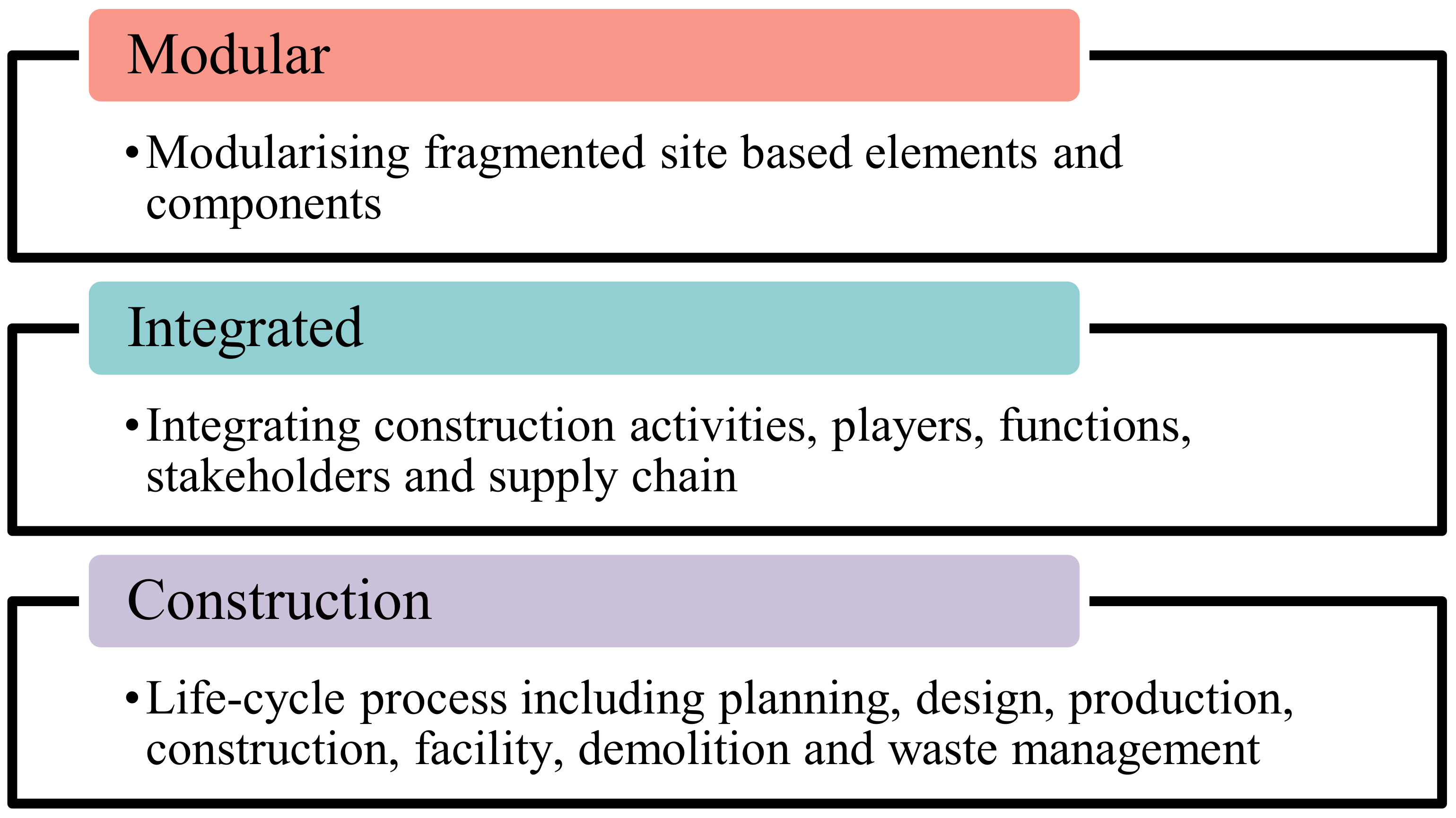



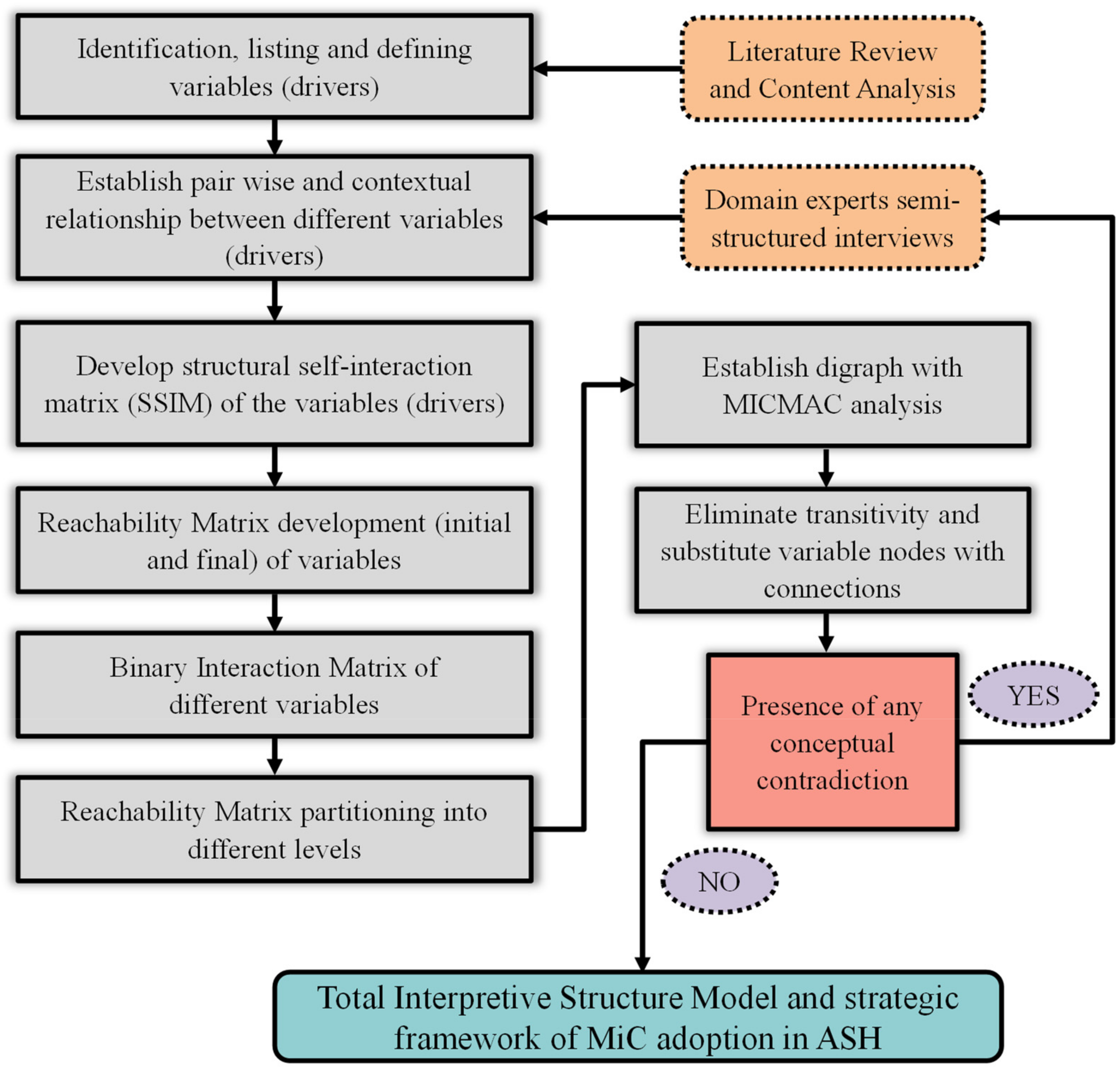
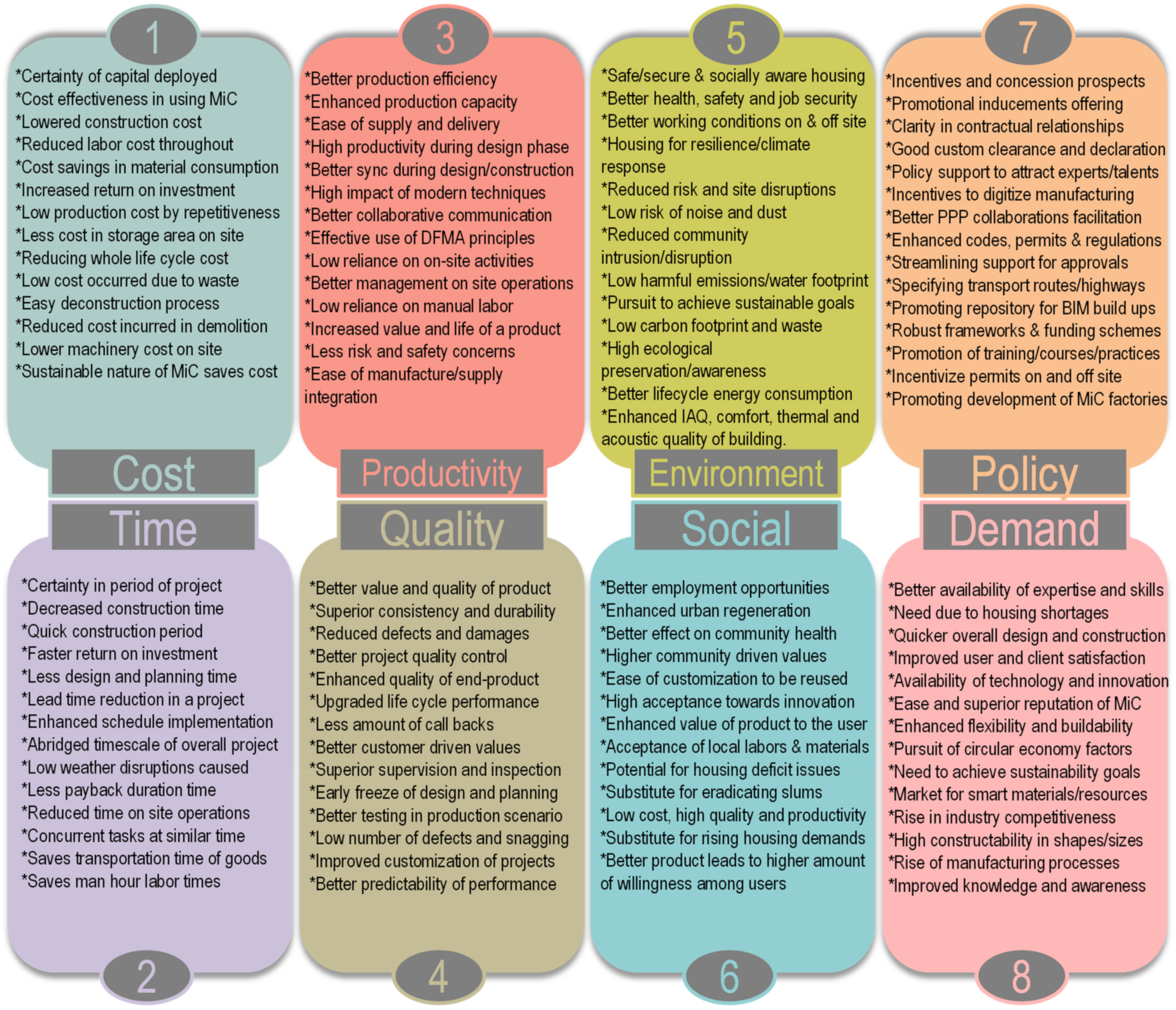


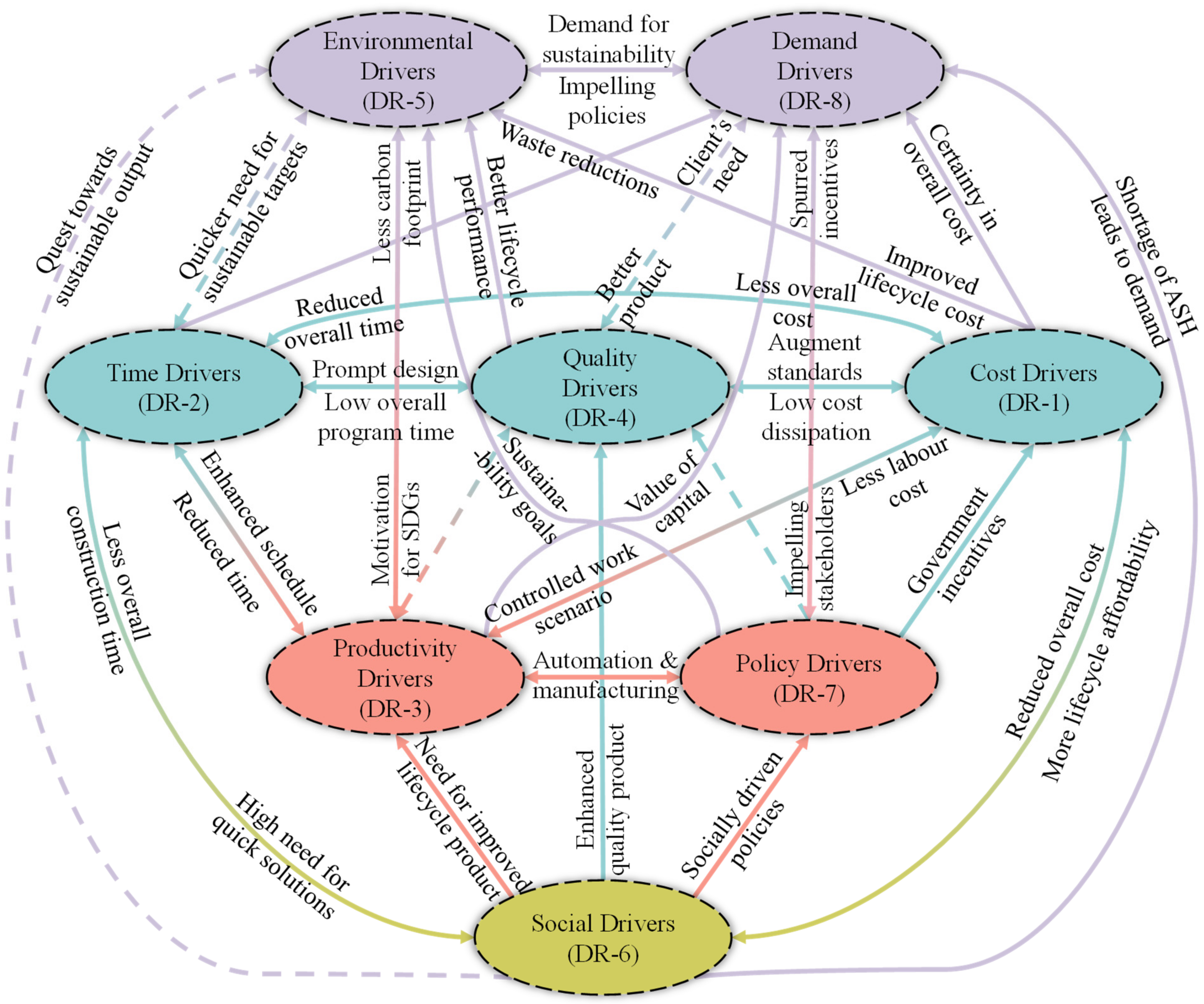
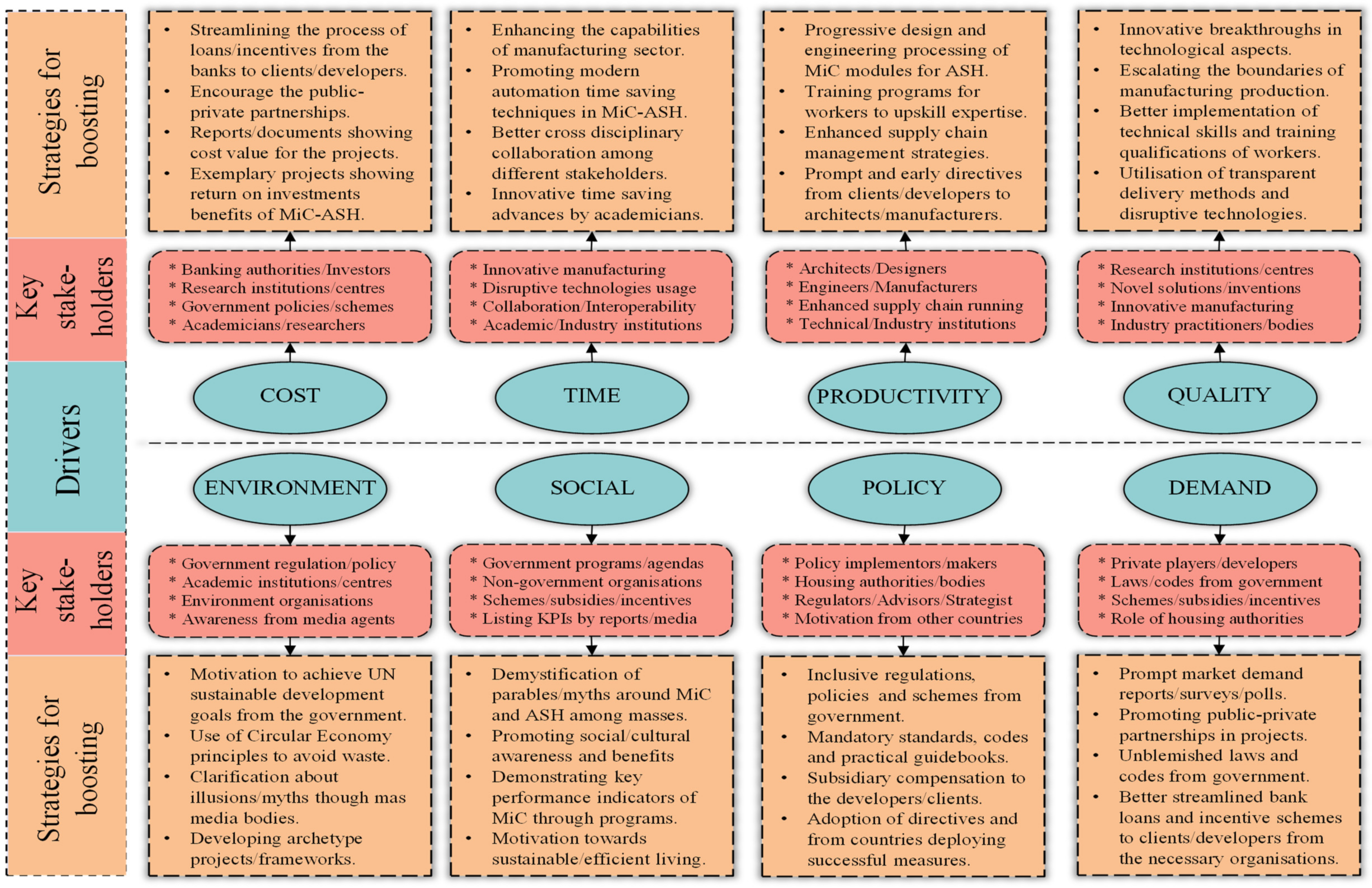
| j | DR-8 | DR-7 | DR-6 | DR-5 | DR-4 | DR-3 | DR-2 | DR-1 | |
|---|---|---|---|---|---|---|---|---|---|
| i | |||||||||
| DR-1 | V | A | X | V | A | X | A | X | |
| DR-2 | V | O | X | O | A | X | X | - | |
| DR-3 | V | V | A | A | X | X | - | - | |
| DR-4 | A | A | A | V | X | - | - | - | |
| DR-5 | V | A | O | X | - | - | - | - | |
| DR-6 | X | X | X | - | - | - | - | - | |
| DR-7 | X | X | - | - | - | - | - | - | |
| DR-8 | X | - | - | - | - | - | - | - | |
| Drivers | DR-1 | DR-2 | DR-3 | DR-4 | DR-5 | DR-6 | DR-7 | DR-8 | Driving Power |
|---|---|---|---|---|---|---|---|---|---|
| DR-1 | 1 | 0 | 1 | 0 | 1 | 1 | 0 | 1 | 5 |
| DR-2 | 1 | 1 | 1 | 0 | 1 | 1 | 0 | 1 | 6 |
| DR-3 | 1 | 1 | 1 | 1 * | 0 | 0 | 1 | 1 | 6 |
| DR-4 | 1 | 1 | 1 | 1 | 1 | 0 | 1 | 0 | 6 |
| DR-5 | 0 | 1 * | 1 | 0 | 1 | 0 | 0 | 1 * | 4 |
| DR-6 | 1 | 1 | 1 | 1 | 0 | 1 | 1 * | 1 | 7 |
| DR-7 | 1 | 0 | 0 | 1 * | 1 | 1 | 1 | 1 | 6 |
| DR-8 | 0 | 1 | 0 | 1 | 0 | 0 | 1 | 1 | 4 |
| Dependency Power | 6 | 6 | 6 | 5 | 5 | 4 | 5 | 7 | - |
| Drivers | Reachability Set | Antecedent Set | Intersection Set | Level |
|---|---|---|---|---|
| DR-1 | 1, 3, 5, 6, 8 | 1, 2, 3, 4, 6, 7 | 1, 3, 6 | 2 |
| DR-2 | 1, 2, 3, 5, 6, 8 | 2, 3, 4, 5, 6, 8 | 2, 3, 5, 6, 8 | 2 |
| DR-3 | 1, 2, 3, 4, 7, 8 | 1, 2, 3, 4, 5, 6 | 1, 2, 3, 4 | 3 |
| DR-4 | 1, 2, 3, 4, 5, 7 | 3, 4, 6, 7, 8 | 3, 4, 7 | 2 |
| DR-5 | 2, 3, 5, 8 | 1, 2, 4, 5, 7 | 2, 5 | 1 |
| DR-6 | 1, 2, 3, 4, 6, 7, 8 | 1, 2, 6, 7 | 1, 2, 6, 7 | 4 |
| DR-7 | 1, 4, 5, 6, 7, 8 | 3, 4, 6, 7, 8 | 4, 6, 7, 8 | 3 |
| DR-8 | 2, 4, 7, 8 | 1, 2, 3, 5, 6, 7, 8 | 2, 7, 8 | 1 |
| Drivers | DR-1 | DR-2 | DR-3 | DR-4 | DR-5 | DR-6 | DR-7 | DR-8 |
|---|---|---|---|---|---|---|---|---|
| DR-1 | - | Reduced overall time | Controlled work scenario | Augmented standards | Waste reductions | More lifecycle affordability | - | Certainty in overall cost |
| DR-2 | Less overall cost | - | Enhanced schedule | Prompt design | Quicker need for sustainable goals | High need for quick solutions | - | - |
| DR-3 | Less labor cost | Reduced time | - | - | Less carbon footprint | - | Call for manufacturing policies | Value of capital |
| DR-4 | Low-cost dissipation | Low overall program time | - | - | Better lifecycle performance | - | - | Client’s demand |
| DR-5 | Improved lifecycle cost | Motivation for SDGs | - | - | - | - | Demand for sustainability | |
| DR-6 | Reduced overall cost | Less overall construction time | Need for improved lifecycle product | Enhanced quality product | The quest towards sustainable output | - | Socially driven policies | Shortage of ASH leads to demand |
| DR-7 | Government incentives | - | Promoting automation | - | Sustainability goals | - | - | Spurred incentives |
| DR-8 | - | - | - | Better product | Impelling policies | - | Impelling stakeholders | - |
Publisher’s Note: MDPI stays neutral with regard to jurisdictional claims in published maps and institutional affiliations. |
© 2022 by the authors. Licensee MDPI, Basel, Switzerland. This article is an open access article distributed under the terms and conditions of the Creative Commons Attribution (CC BY) license (https://creativecommons.org/licenses/by/4.0/).
Share and Cite
Khan, A.; Yu, R.; Liu, T.; Guan, H.; Oh, E. Drivers towards Adopting Modular Integrated Construction for Affordable Sustainable Housing: A Total Interpretive Structural Modelling (TISM) Method. Buildings 2022, 12, 637. https://doi.org/10.3390/buildings12050637
Khan A, Yu R, Liu T, Guan H, Oh E. Drivers towards Adopting Modular Integrated Construction for Affordable Sustainable Housing: A Total Interpretive Structural Modelling (TISM) Method. Buildings. 2022; 12(5):637. https://doi.org/10.3390/buildings12050637
Chicago/Turabian StyleKhan, Ayaz, Rongrong Yu, Tingting Liu, Hong Guan, and Erwin Oh. 2022. "Drivers towards Adopting Modular Integrated Construction for Affordable Sustainable Housing: A Total Interpretive Structural Modelling (TISM) Method" Buildings 12, no. 5: 637. https://doi.org/10.3390/buildings12050637
APA StyleKhan, A., Yu, R., Liu, T., Guan, H., & Oh, E. (2022). Drivers towards Adopting Modular Integrated Construction for Affordable Sustainable Housing: A Total Interpretive Structural Modelling (TISM) Method. Buildings, 12(5), 637. https://doi.org/10.3390/buildings12050637









